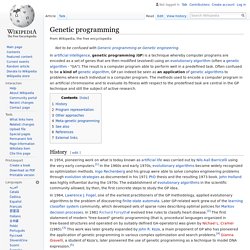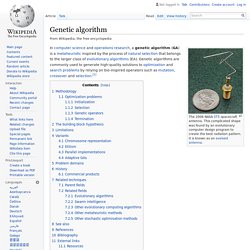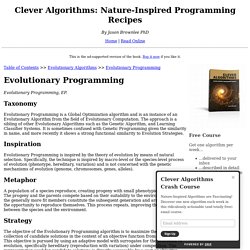

The synuclein family. What do we mean by Open-Ended Evolution? : oee. Exploring the Concept of Open-Ended Evolution. Evolutionary computation. In computer science, evolutionary computation is a subfield of artificial intelligence (more particularly computational intelligence) that involves continuous optimization and combinatorial optimization problems.

Its algorithms can be considered global optimization methods with a metaheuristic or stochastic optimization character and are mostly applied for black box problems (no derivatives known), often in the context of expensive optimization. Evolutionary computation uses iterative progress, such as growth or development in a population. This population is then selected in a guided random search using parallel processing to achieve the desired end. Genetic programming. In artificial intelligence, genetic programming (GP) is a technique whereby computer programs are encoded as a set of genes that are then modified (evolved) using an evolutionary algorithm (often a genetic algorithm - "GA").

The result is a computer program able to perform well in a predefined task. Often confused to be a kind of genetic algorithm, GP can indeed be seen as an application of genetic algorithms to problems where each individual is a computer program. The methods used to encode a computer program in an artificial chromosome and to evaluate its fitness with respect to the predefined task are central in the GP technique and still the subject of active research. History[edit] Scientists create 'artificial evolution' for the first time. Scientists have made a significant step towards developing fully artificial life – for the first time, they demonstrated evolution in a simple chemistry set without DNA.

In a way, the researchers showed that the principle of natural selection doesn’t only apply to the biological world. Using a simple a robotic ‘aid’, a team from the University of Glasgow managed to create an evolving chemical system. They used an open source robot based upon a cheap 3D printer to create and monitor droplets of oil. Genetic programming. In artificial intelligence, genetic programming (GP) is a technique whereby computer programs are encoded as a set of genes that are then modified (evolved) using an evolutionary algorithm (often a genetic algorithm - "GA").

The result is a computer program able to perform well in a predefined task. Often confused to be a kind of genetic algorithm, GP can indeed be seen as an application of genetic algorithms to problems where each individual is a computer program. The methods used to encode a computer program in an artificial chromosome and to evaluate its fitness with respect to the predefined task are central in the GP technique and still the subject of active research. Evolutionary computation. In computer science, evolutionary computation is a subfield of artificial intelligence (more particularly soft computing) that can be defined by the type of algorithms it is concerned with.

These algorithms, called evolutionary algorithms, are based on adopting Darwinian principles, hence the name. Technically they belong to the family of trial and error problem solvers and can be considered global optimization methods with a metaheuristic or stochastic optimization character, distinguished by the use of a population of candidate solutions (rather than just iterating over one point in the search space). The application of recombination and evolutionary strategies makes them less prone to get stuck in local optima than alternative methods.[1] Evolutionary computation uses iterative progress, such as growth or development in a population. Evolutionary programming. Evolutionary programming is one of the four major evolutionary algorithm paradigms.

It is similar to genetic programming, but the structure of the program to be optimized is fixed, while its numerical parameters are allowed to evolve. It was first used by Lawrence J. Fogel in the US in 1960 in order to use simulated evolution as a learning process aiming to generate artificial intelligence. Fogel used finite-state machines as predictors and evolved them. Currently evolutionary programming is a wide evolutionary computing dialect with no fixed structure or (representation), in contrast with some of the other dialects. Evolutionary programming. Evolutionary computation. Evolution strategy. History[edit] The 'evolution strategy' optimization technique was created in the early 1960s and developed further in the 1970s and later by Ingo Rechenberg, Hans-Paul Schwefel and their co-workers.

Methods[edit] As far as real-valued search spaces are concerned, mutation is normally performed by adding a normally distributed random value to each vector component. The step size or mutation strength (i.e. the standard deviation of the normal distribution) is often governed by self-adaptation (see evolution window). Evolver (software) Portal:Evolutionary biology. Evolutionary computation. Genetic algorithm. The 2006 NASA ST5 spacecraft antenna.

This complicated shape was found by an evolutionary computer design program to create the best radiation pattern. It is known as an evolved antenna. Methodology[edit] Genetic programming. In artificial intelligence, genetic programming (GP) is a technique whereby computer programs are encoded as a set of genes that are then modified (evolved) using an evolutionary algorithm (often a genetic algorithm - "GA").

The result is a computer program able to perform well in a predefined task. Often confused to be a kind of genetic algorithm, GP can indeed be seen as an application of genetic algorithms to problems where each individual is a computer program. The methods used to encode a computer program in an artificial chromosome and to evaluate its fitness with respect to the predefined task are central in the GP technique and still the subject of active research. Evolutionary Programming - Clever Algorithms: Nature-Inspired Programming Recipes. Evolutionary Programming, EP.

Taxonomy Evolutionary Programming is a Global Optimization algorithm and is an instance of an Evolutionary Algorithm from the field of Evolutionary Computation. The approach is a sibling of other Evolutionary Algorithms such as the Genetic Algorithm, and Learning Classifier Systems. It is sometimes confused with Genetic Programming given the similarity in name, and more recently it shows a strong functional similarity to Evolution Strategies. Inspiration. Q1.2 - HHGT Evolutionary Computation.
Introduction EVOLUTIONARY PROGRAMMING, originally conceived by Lawrence J. Fogel in 1960, is a stochastic OPTIMIZATION strategy similar to GENETIC ALGORITHMs, but instead places emphasis on the behavioral linkage between PARENTs and their OFFSPRING, rather than seeking to emulate specific GENETIC OPERATORs as observed in nature. Evolutionary programming is similar to EVOLUTION STRATEGIEs, although the two approaches developed independently (see below).